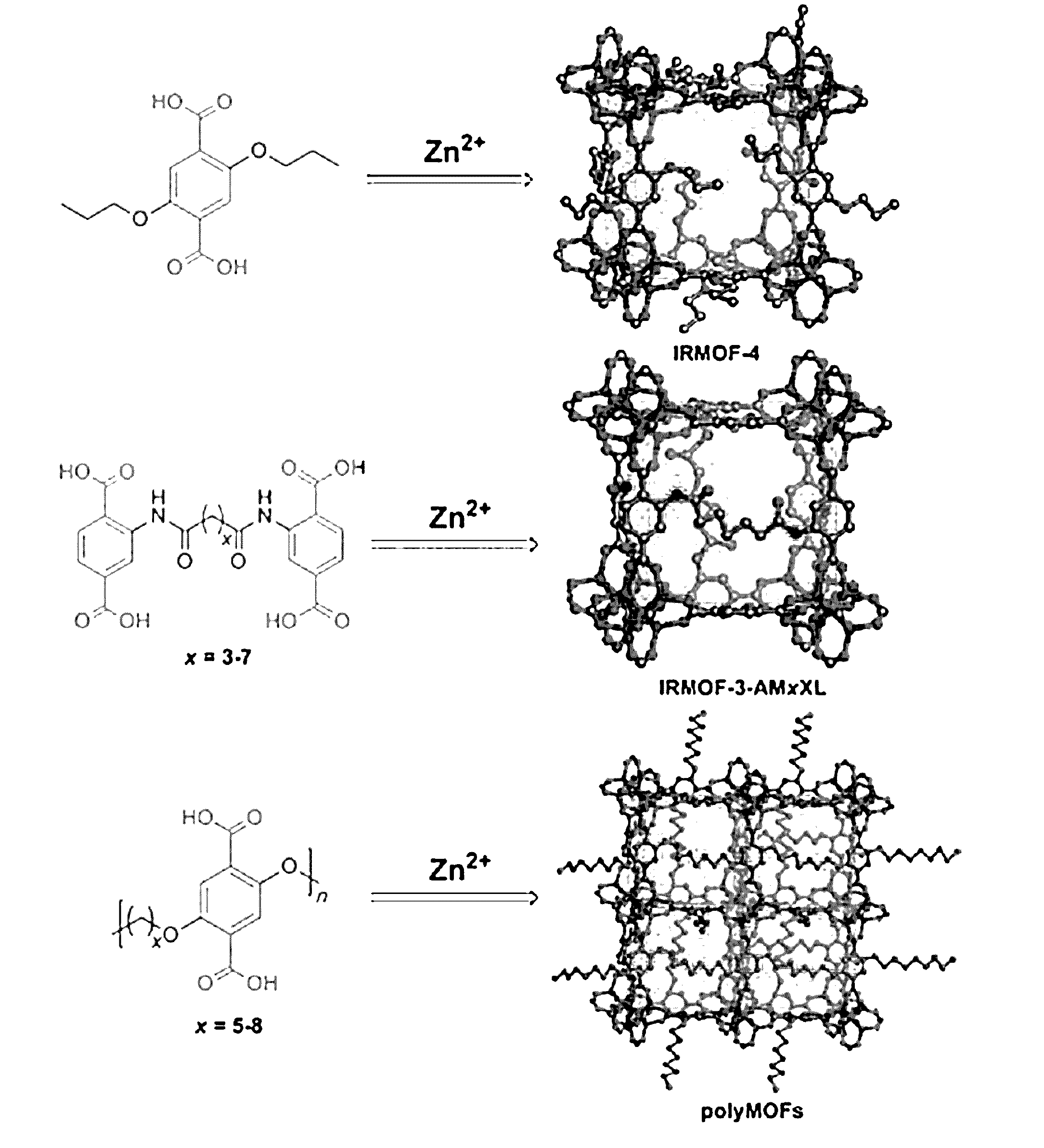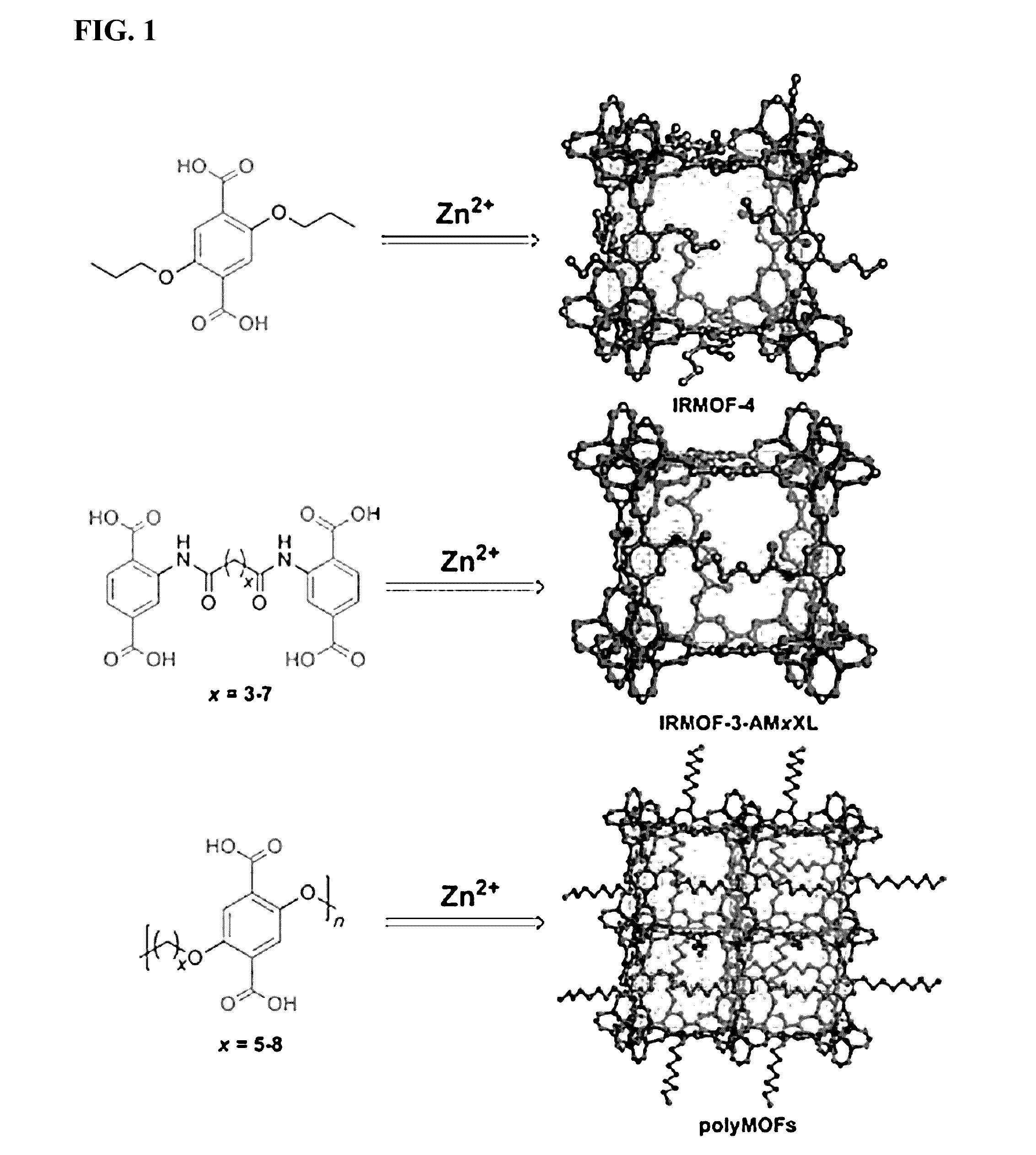Polymer-metal organic framework materials and methods of using the same
- Summary
- Abstract
- Description
- Claims
- Application Information
AI Technical Summary
Benefits of technology
Problems solved by technology
Method used
Image
Examples
example 1
PolyMOFs: A Class of Interconvertible Polymer-Metal Organic-Framework Hybrid Materials
[0234]The preparation of porous materials from 1-dimensional polymers is challenging because the packing of polymer chains may result in a dense, non-porous arrangement. Herein this example, we demonstrate the remarkable adaptation of an amorphous, linear, non-porous, flexible organic polymer into a 3-dimensional, highly porous, crystalline solid, as the organic component of a metal organic framework (MOF). In embodiments, a polymer with aromatic dicarboxylic acids in the backbone functioned as a polymer-ligand upon annealing with Zn(II)-generating a polymer-metal organic-framework (polyMOF). These materials uproot the dogma that MOFs must be prepared exclusively from small, rigid ligands. Similarly, polyMOFs contradict conventional polymer chemistry by demonstrating that linear and amorphous polymers can be readily coaxed into a highly crystalline, porous, 3-dimensional structure via coordination ...
example 2
Variations of the Covalent Linker Moieties
[0273]There is provided an approach to prepare a series of MOFs isostructural to IRMOF-1 (also referred to herein as MOF-5) by using cross-linked terephthalate (BDC) ligands, which were synthesized by tethering two or three BDC monomer with alkyl or xylene linkers. Based on this example, and without being bound by any theory, it is believed that polymer ligands with cross-linked BDC moieties produce crystalline polymer-MOF hybrid materials isostructural to IRMOF-1.
[0274]Synthesis Procedure of Polymer Ligands:
[0275]Potassium carbonate (2.63 g, 19.03 mmol) was added to a stirred solution of diethyl-5-hydroxyisophthalate (1.208 g, 4.75 mmol) and dibromoalkyl (4.75 mmol) in acetone / dimethyl sulfoxide (33 mL, 10:1). The mixture was heated at 80° C. in oil bath for 24 h. ˜50 mL water was added into the suspension solution and the solid was centrifuged. The harvested solid was washed with Acetone and MeOH each for 3 times with centrifugation. The f...
example 3
PolyMOFs as Water Tolerant Materials for Selective Carbon Dioxide Separations
[0278]Metallopolymer materials have received increasing attention due to their properties as stimulus-responsive, self-healing, conductive, photo- and electroluminescence, catalysis, and drug delivery materials. Metallopolymer materials are typically amorphous due to the high flexibility and random conformation of the polymer chains. Synthesis of highly crystalline metallopolymers is challenging, but recently polymer-metal organic frameworks (polyMOFs) have been reported as a new class of hybrid metallopolymer material that combines features of both organic polymers and crystalline MOFs. Amorphous, linear, and non-porous polymer ligands were shown to coordinate with metal ions to form highly crystalline, 3-dimensional, porous framework materials. From a synthesis perspective, this approach upends conventional wisdom in both polymer and MOF chemistry, as linear polymers are not easily organized into 3-dimens...
PUM
| Property | Measurement | Unit |
|---|---|---|
| temperature | aaaaa | aaaaa |
| average molecular weight | aaaaa | aaaaa |
| average molecular weight | aaaaa | aaaaa |
Abstract
Description
Claims
Application Information
 Login to View More
Login to View More - R&D
- Intellectual Property
- Life Sciences
- Materials
- Tech Scout
- Unparalleled Data Quality
- Higher Quality Content
- 60% Fewer Hallucinations
Browse by: Latest US Patents, China's latest patents, Technical Efficacy Thesaurus, Application Domain, Technology Topic, Popular Technical Reports.
© 2025 PatSnap. All rights reserved.Legal|Privacy policy|Modern Slavery Act Transparency Statement|Sitemap|About US| Contact US: help@patsnap.com



